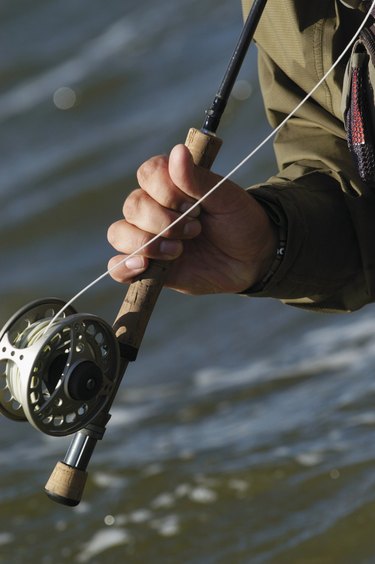Things You'll Need
3 pieces of fishing line, 30 inches long
6 crimp beads
2 jump rings
Flat-nose pliers or crimping pliers
Beading needle
Small beads
Scissors
3 spacer beads, 3 holes each
Jewelry clasp

Homemade bracelets can be constructed from all sorts of different materials. From wire and thread to hemp and embroidery floss, every type of stringing material serves a different purpose and helps you achieve a different look in your final design. Fishing line, typically a monofilament, is not just for fans of the outdoors. In the world of crafts, it is a clear option for stringing your beaded jewelry and is favored for its strength and durability.
Step 1
Isolate a single piece of fishing line. Slide a crimp bead approximately an inch from the end of the line. Slide a jump ring on the line immediately after the crimp bead. Bend the fishing line at the jump ring and feed the tail of the fishing line back through the crimp bead to create a loop. Slide the crimp bead toward the jump ring to tighten the loop, leaving a fraction of an inch of leeway, and then use pliers to flatten your crimp bead and secure the fishing wire in place.
Video of the Day
Step 2
Slide a crimp bead onto the end of a second piece of fishing line. String the same jump ring used for Step 1 onto the end of the fishing line. Create a loop again by bending the fishing line backward at the point of the jump ring and threading its tail through the crimp bead. Slide the crimp bead toward the jump ring, as before, and flatten it with your pliers. Repeat with the third piece of fishing line so that all three pieces are attached to the same jump ring.
Step 3
Thread your beading needle with one of the pieces of fishing line. Slide a single bead onto the line and toward the opposite end. As you near the end, slip the bead onto the short piece of fishing line -- the piece you bent back from the jump ring -- and slide it all the way to the crimp bead. Trim the excess from the short piece of fishing line.
Step 4
Continue to bead by sliding each bead onto the needle and down the fishing wire. Stop after threading 10 to 20 beads, depending on the size of your beads, or as your bracelet nears a quarter of its final length.
Step 5
Repeat the initial beading process on both other pieces of fishing line. Remember to thread the first bead of the strand onto the short piece of fishing line and trim the excess before continuing.
Step 6
Feed all three pieces of fishing line through a 3-hole spacer bead. Be sure not to twist the lines. Slide the spacer bead down the length of the bracelet to meet the other beads.
Step 7
Continue threading each strand separately until you've completed another quarter of your bracelet after approximately 10 to 20 more beads, then slide another spacer bead onto all three strands. Repeat twice more, but omit the final spacer bead on your last repetition.
Step 8
Isolate a single strand. String a crimp bead onto the line followed by a jump ring, as you did before. Bend the wire in a loop and thread it back through the crimp bead. Slide the crimp bead toward the jump ring, then pull the short end of the line to tighten the bracelet and get rid of gaps in your beading. Flatten your crimp bead with pliers, insert the short tail of fishing line backwards into the final bead -- from the end of the bracelet toward the beginning -- and trim the excess.
Step 9
Repeat the final crimping process on both other strands. Use the same jump ring on the first strand so that all three strands are joined to the same jump ring, mirroring the opposite side.
Step 10
Grip one side of either jump ring with your fingers. Use your pliers to pull the other side out of alignment, opening the ring. Insert one half of your jewelry clasp. Use your pliers to close the jump ring by reversing your previous action. Repeat on the opposite end of the bracelet to attach the other portion of the clasp.
Tip
Be sure that your needle is narrow enough to pass through your beads and that your beads are larger than the holes in your spacers.
Video of the Day